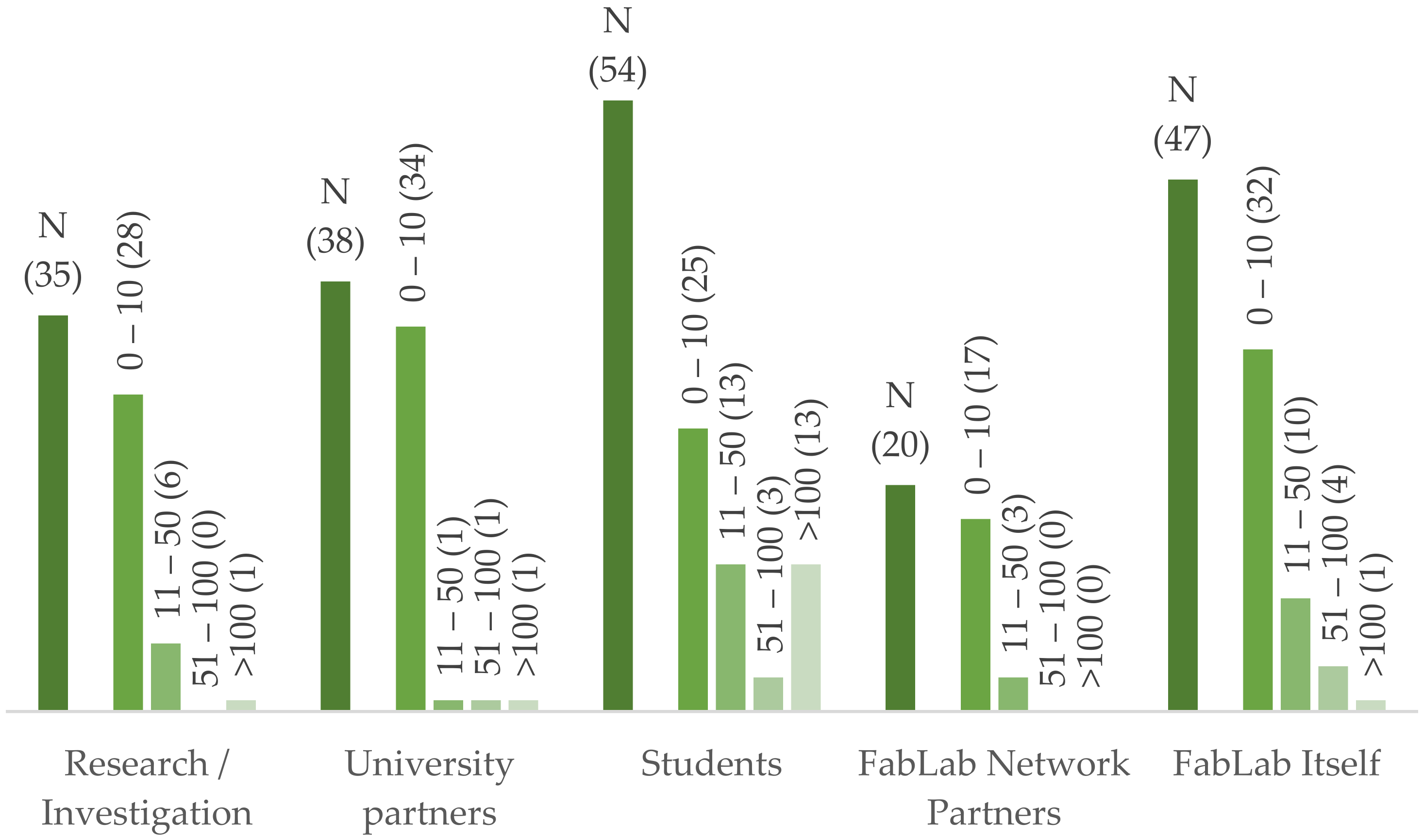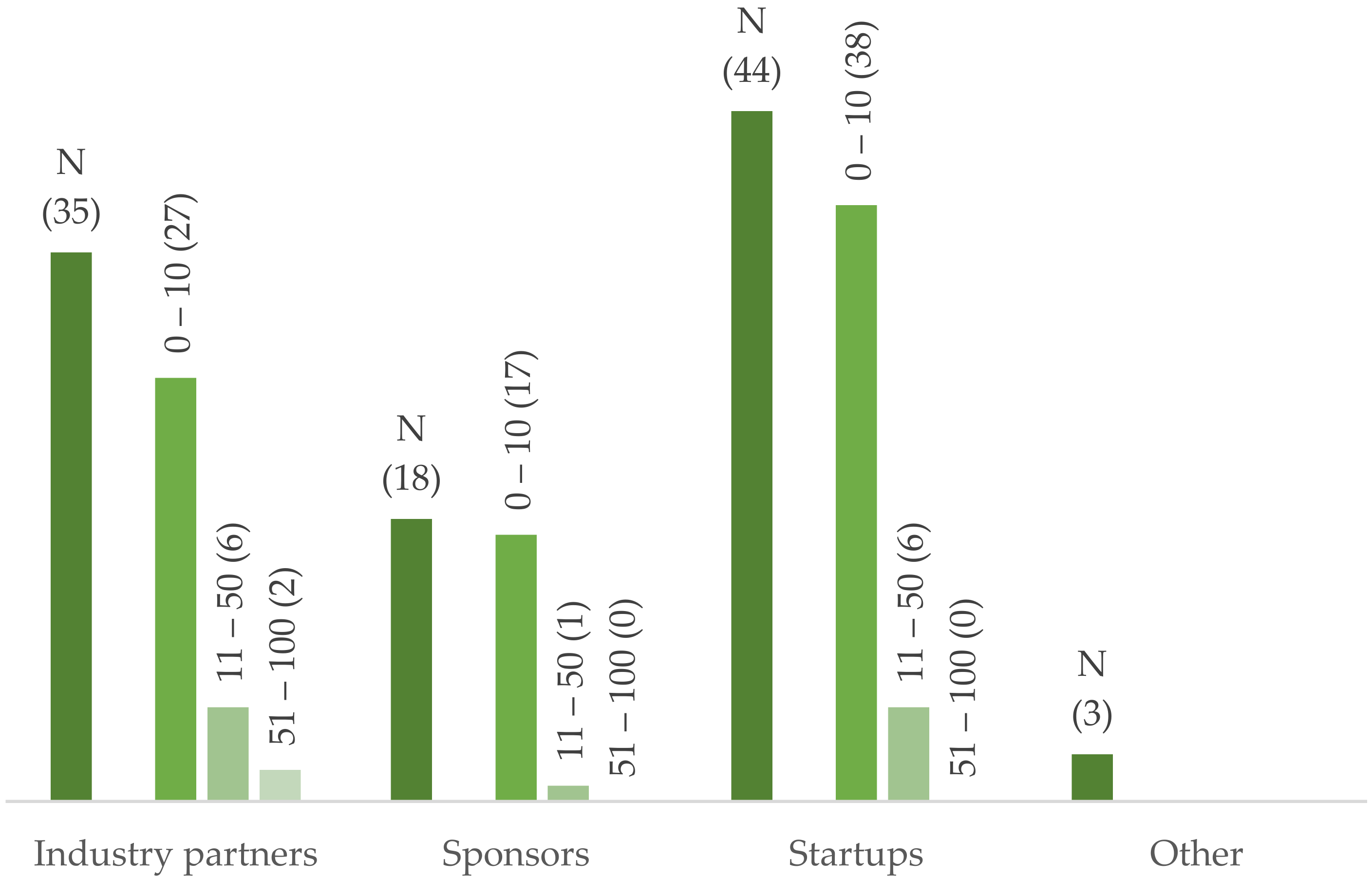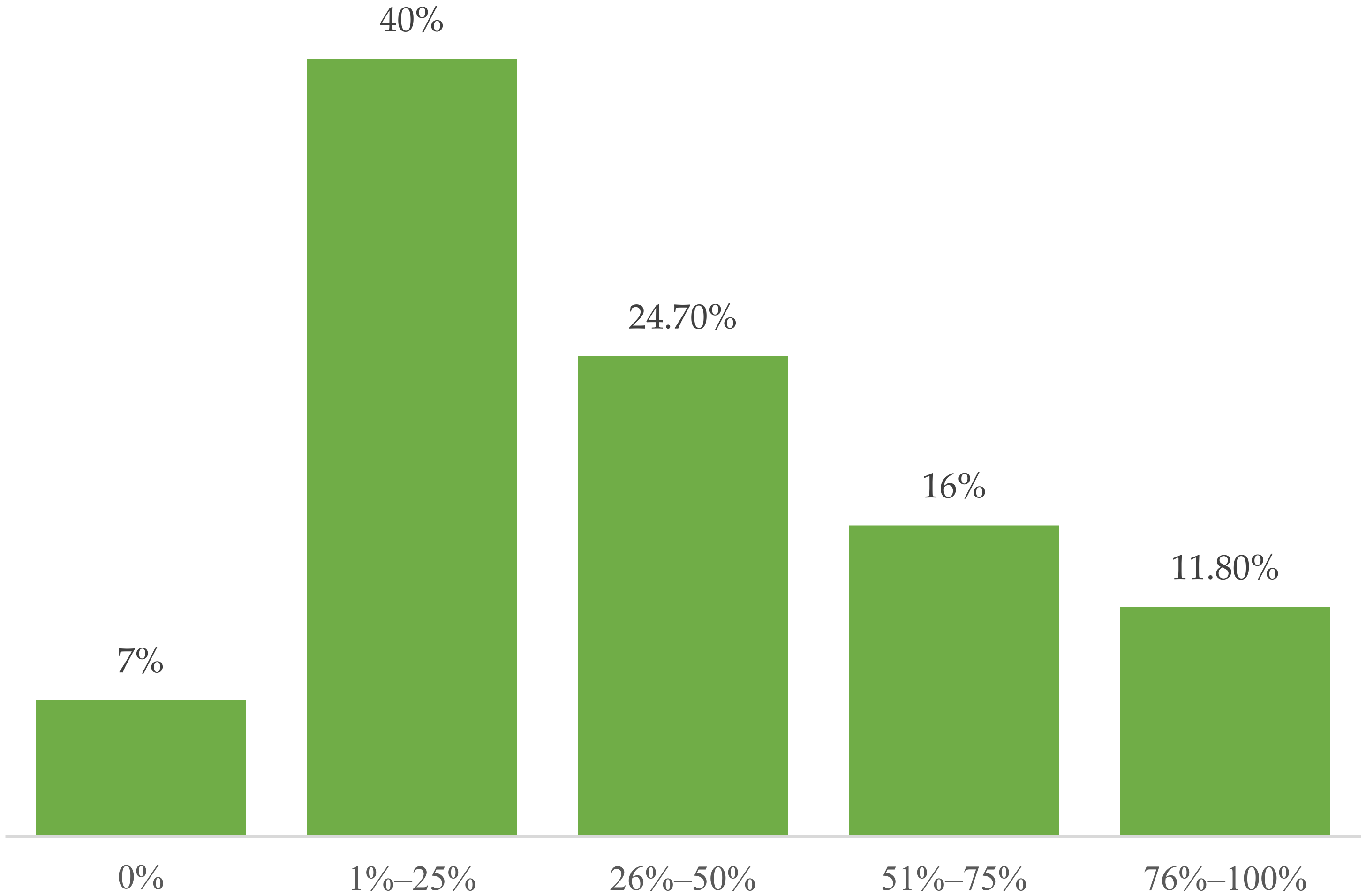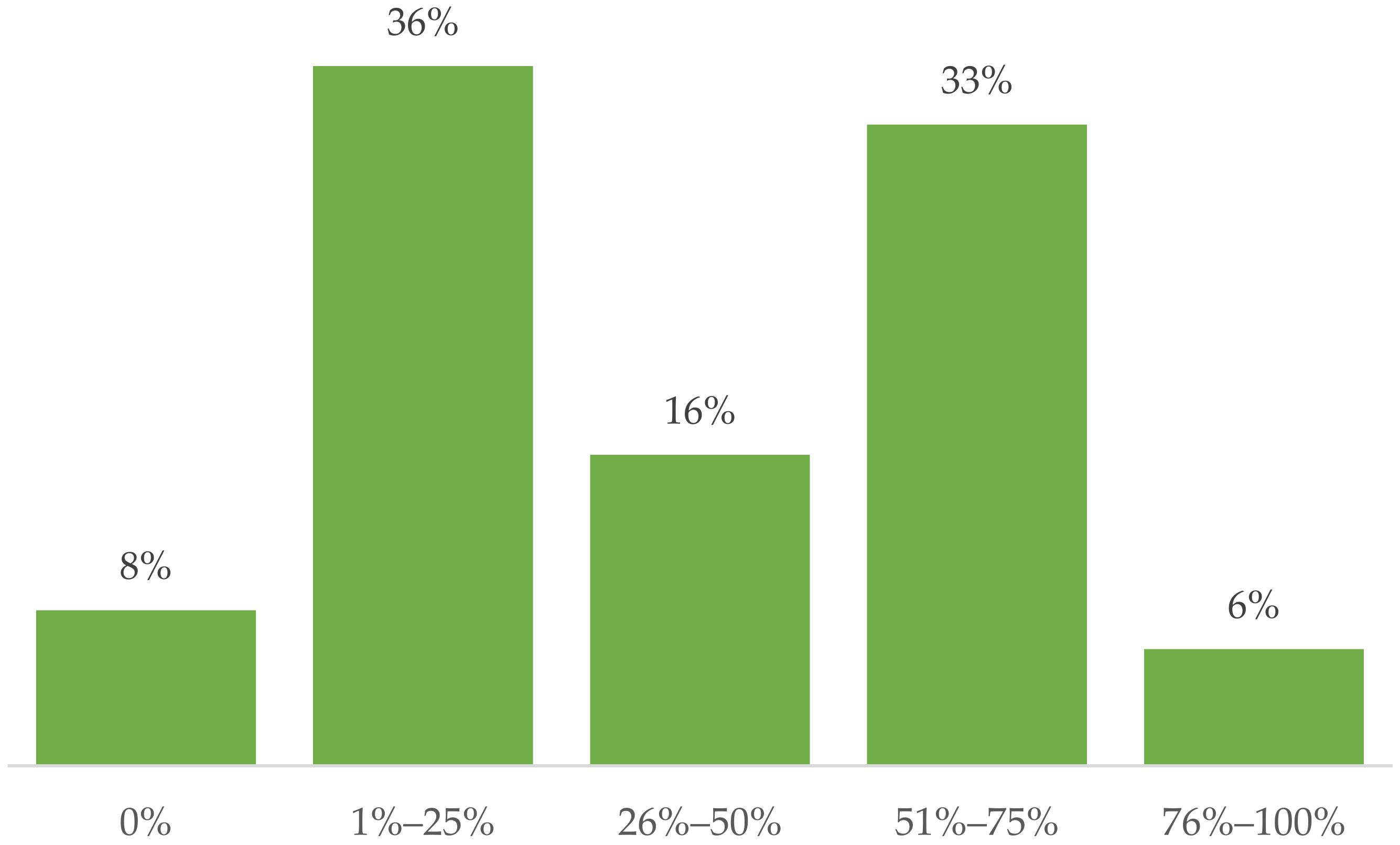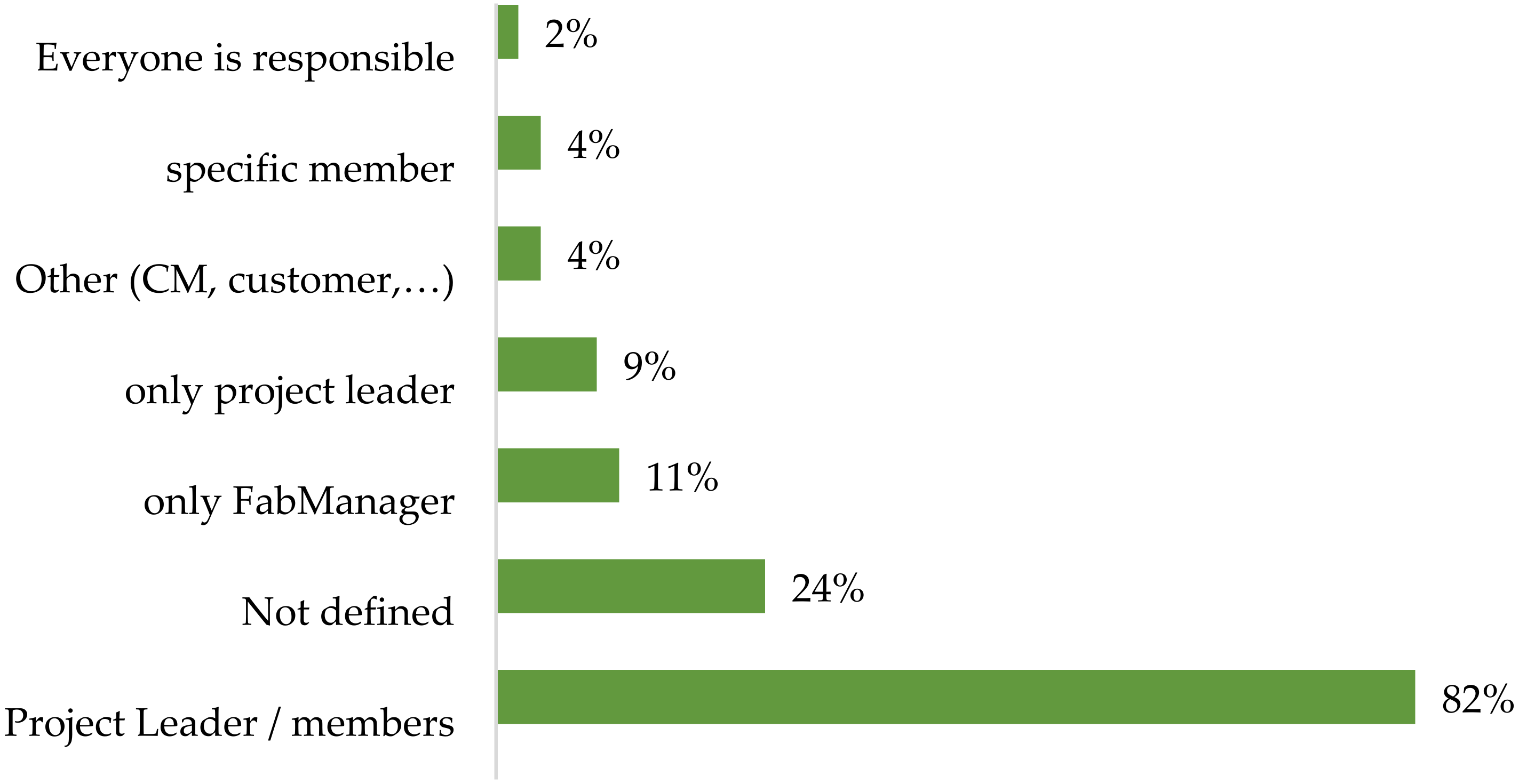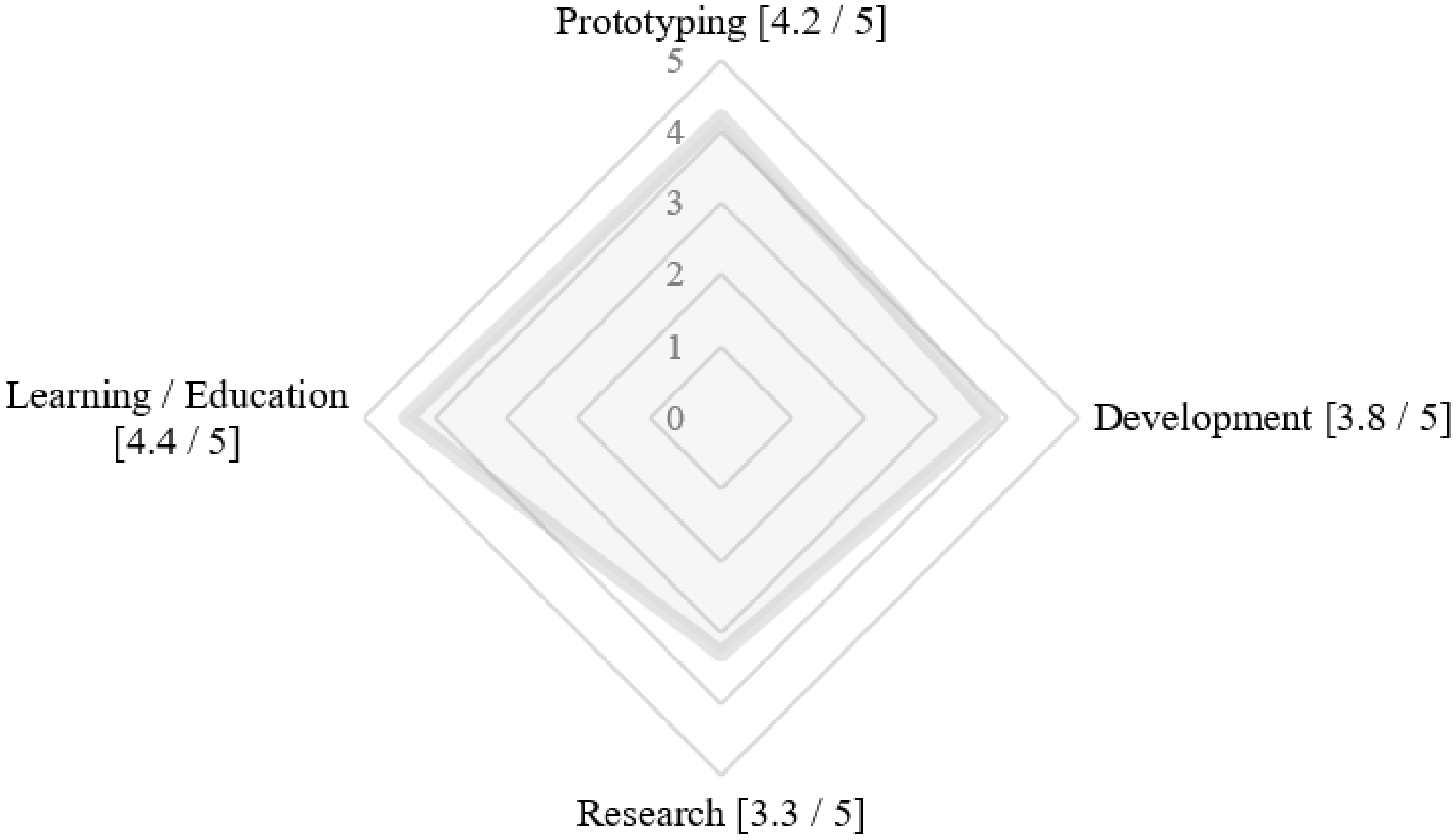It is necessary to note that, despite the importance of digital skills in today’s changing world and the existence of multiple elements that bring these skills to citizens, many non-experts see difficulties in accessing this maker culture, understood as an amateur and professional movement that includes the use of digital manufacturing technology and software with traditional manufacturing methods to create or customize objects
[4]. Immersed in this maker culture and despite its popularity, FabLabs still have the problem that any advanced technology has for general users: the difficulty of use. Despite the growing popularity of this technology, users express a lack of skills and/or essential experience necessary for the design or use of the various techniques involved in digital manufacturing; there is a high level of complexity in the action and overall management required, for example, for the use of 3D design software or a favorite 3D printer that, despite interfaces and systems, have relatively simple operations. This lack of skills, many self-perceived by users, is a barrier for entry to digital manufacturing processes, the related technology and maker environments in general. This difficulty is usually solved only through actual access to the technology offered in these places or through the occasional workshops or training activities in the maker areas. The substantial impairment that requires access to this basic knowledge in digital manufacturing is overcome by working in the community, group learning and medium- and long-term project development to achieve the involvement of users in actions aimed for children and adults. In this respect, the projects in makerspaces in general, and the FabLab in particular, often act as transformations of the population in which they find themselves, working directly in their development, as a union or open to the community generation of non-expert users actively evolving learning, as demonstrated in FabLab Genk
[4].
The participation of citizens in the programs developed in the FabLab also includes the realization of technologically advanced research projects through citizen science. In these programs, users become nodes of research in the development and use of many useful information devices, which is difficult to achieve otherwise. These programs, such as the Smart Citizen program conducted by FabLab Barcelona
[6] or the MicroMascotas program mentored by César Laboratories in Etopía (FabLab Zaragoza)
[7], include the massive participation of citizens, users and non-users of the FabLab; organizers, data collection tools and technological developments are made at very low cost, often by users themselves with open instructions. Through open calls, and thanks to the participation of various public entities, FabLabs realize incredible projects that are proposed, designed and led by citizens who, despite not having the means or the necessary knowledge, benefit from the participation of other users who perform tasks of high complexity. The Servet experimental stratosphere project, also developed in the Cesar laboratory in Etopía (FabLab Zaragoza), is a good demonstration of this
[8]. This new wave of citizen involvement helps transform the cities from passive elements that are “product in, trash out” to living elements that generate knowledge, i.e., “data in, data out”. Here, the usual waste, technology and information are included in a fundamental element of sustainability that turns cities in the next model to FabCity, where information technologies redefine the use of the towns to obtain a new productive, economic and social dimension
[6].
Socially, and despite the various programs that they develop, FabLabs embody many of the social stereotypes of the cultural environment in which they are included. Classically, despite great social advances in equality, technology has been dominated by males, in the so-called “gender gap”. Excluding natural gender equality and maintaining a strong differentiation is strengthened by social customs that make up the established roles, from the linguistic construction itself to the assumption of different cultural values. This classic “gender gap” seems also to be reflected in the distribution of users in FabLabs, where some studies show slightly higher female participation of 25%
[9], far from equal participation. It is obviously not possible to generalize from these figures due to the diversity of FabLabs as cultural spaces and the variety of orientations, themes and projects which makes it impossible to extrapolate, as rightly noted by the authors of the study mentioned. The multiplicity of FabLab types scattered throughout the world promotes differences in the gender distribution of their users; countries such as Brazil have shown a greater elimination of differences in the participation of the genders, approaching parity
[10]. Indeed, FabLabs reflect the differentiation that society sets, and despite the egalitarian mentality of these cultural environments, the existence of multiple programs for female empowerment and their inclusion in both the maker environment and in the FabLabs themselves, the ever-growing presence of women in FabLabs in technical roles and as FabLab managers and the impact on education and training programs open to egalitarian goals, laboratories are still far from achieving the equality pursued. An example of the type of program developed in the FabLab initiative is the Poderosas program in FabLab León
[11], which aims to encourage female commitment to technology and digital manufacturing, improving self-confidence through exclusive programming activities for girls. These types of programs activate the curiosity of young users, enhancing their willingness to join higher education related to science and technology, where the male presence is classically predominant.
2. Distinctive Features
Once the physical, social and economic conditions laboratories are identified, the researchers focus on their distinguishing characteristics, among which are the ability to promote entrepreneurship (through fast prototyping, level of innovation, collaboration with other entities, or due to independence in project development), the training offered and the public documentation of projects undertaken to conclude with their contribution to the community.
2.1. Entrepreneurship and Fast Prototyping
The FabLab can serve as a vivarium for business development, improving products and processes or generating prototypes that constitute the minimum viable product of a commercial initiative. Among the FabLab Global Survey participants, 22.9% had witnessed the creation of a new commercial initiative, stressing the importance of these processes.
The economic sustainability of these laboratories is, however, even today, an added difficulty for their own characteristics, causing many of them to depend in one way or another on the entity that hosts them. This kind of dependence could well place a limitation on the development of projects by establishing clear preferences in their choice, skewing the typology of their development or limiting the involvement of the laboratory in certain types of activities.
Answers provided by the participants show a high perception of the contribution of the FabLab as a factor in the development of entrepreneurial culture (73% of respondents rated their agreement with a 4 or 5 out of 5). A positive impact is noted on the contribution of the close ecologies to the FabLab, as positive factors in the development of entrepreneurial culture (73% of respondents rated their agreement with a 4 or 5 out of 5). The perception of fast prototyping as a contribution is also highly considered (90% of respondents rated it with 4 or above out of 5 as seen ), probably due to involvement in innovation processes.
The FabLab Global Survey evaluated the perception of independence in carrying out different projects. The participants were asked to indicate the perceived independence of the realization of the FabLab projects on a 1 to 5 scale, with 1 meaning a null independence, and therefore a full dependence, and 5 meaning a complete independence. It is important to consider that while a large percentage of laboratories are dependent on institutions to ensure sustainability, 68% of laboratories indicated a high level of independence, and 52% of the participants indicated a level of absolute independence (Figure 1).
Figure 1. Distribution of laboratories according to declared independence.
2.2. Development of Joint Projects with Other Institutions and Groups
In the FabLab Global Survey, the participants were asked about the realization of joint projects with certain typical institutions in the FabLab environment. Among the participating laboratories, 43.5% had jointly carried out projects with external industries, although only 9.4% of the participants had carried out more than 10 projects. Twenty-four percent of participants reported having developed projects with sponsors, but only one participant carried out more than 10 projects. On the other hand, 45.9% of the participants indicated that they had carried out projects with research entities, although only 8.2% of the participants had completed more than 10 projects of this type. While 48.2% of the laboratories had carried out projects in collaboration with universities, only 1.18% of the laboratories developed more than 10 projects of this type. The projects carried out with students were the most common collaborative projects, present in 68.2% of the cases, where 34% of the participants exceeded 10 projects of this type and 15.3% had developed 100 projects. Only 24.7% of the laboratories had carried out joint projects with other laboratories in the FabLab Network, and only 3.5% had realized 10 projects (Figure 2 and Figure 3).
Figure 2. Distribution of number of projects developed.
Figure 3. Distribution of number of projects developed (industrial section).
2.3. Level of Innovation, the Percentage of Innovation Projects Developed Jointly
The projects developed in the environment of FabLabs are adjusted to multiple and different interests and objectives and, therefore, tend to be varied despite their common ground in digital manufacturing. One of the interests of this research was identifying the contribution of the projects carried out in the laboratories to innovation, for which an item was included in the FabLab Global Survey where participants were asked about the approximate percentage of projects carried out dedicated to innovation for research and development for industrial companies or small businesses. The results reveal that 27.8% of the laboratories had a high percentage of projects linked with innovation—more than 50% of the projects—with 11.8% of the cases considered as a very high level—more than 75% of the projects. By contrast, 40% of the laboratories reported a very low level of projects linked to innovation—less than 25% of projects dedicated to innovation. A meager 7% of the laboratories reported no projects linked to innovation (Figure 4).
Figure 4. Percentage of projects related to innovation.
The communities that emerge within a FabLab often share the point of view of one of the key roles present in their daily lives: the FabManager. The FabManager is, along with the rest of the technical staff, the soul of the laboratory. They know the function of all available material—some of the machinery has even been created by them or with their essential collaboration—and participate in all processes that are taking place in the laboratory, in most cases being a fundamental part of them. It is thus interesting to hear their opinion of aspects such as the contribution of the FabLab to entrepreneurship development, the process of project documentation or the training of users.
2.4. Documentation
Another important aspect to consider in this section involves the internal processes associated with public FabLab project documentation. As suggested by the FabLab Charter
[3][12][13], a FabLab has a responsibility to disseminate the knowledge generated in the projects through its public documentation. Project documentation is an added difficulty in development since it involves time and resources, rarely available in digital manufacturing laboratories. This feature is not exclusive to FabLabs, as it is shared with the culture of the maker movement.
Documentation seems to be perceived as an obstacle and represents a serious difficulty in the development of projects; however, a common platform for the documentation process has not been established (although some joint initiatives from within the network of FabLabs have been developed and there are some attempts to standardize the documentation process), and relatively few laboratories make the public documentation process a priority using an online platform. Several items were included in FabLab Global Survey concerning the documentation process, from the items designed to assess the perception of documentation to items that were intended to determine who is ultimately responsible for the documentation process and items that evaluate the actual percentage of documented projects. Most of the participants expressed the great importance of project documentation as one of the main benefits of FabLab (68% of participants) and also the difficulty that it represents (53% participants).
When asked about the importance of documentation in their own FabLab in particular, 65% of participants reported a high or very high importance and 18% admitted a relatively low importance. Although 68% of respondents considered the public documentation of projects as one of the great strengths of the FabLab, 51% recognized it as one of its great difficulties (Figure 5).
Figure 5. Evaluation of the importance of the documentation processes for the FabLab.
If the researchers focus on the actual percentage of publicly documented projects, 39% of the laboratories showed a high rate of documented projects (more than 50% of the projects documented) while only 6% assumed a very high rate (more than 75% of projects). The difficulty associated with project documentation seems to be the reason for the high number of laboratories with a low rate of documented projects, demonstrated by 36% of participants having more than 25% of projects documented and 8% of laboratories without any projects documented. It is interesting to note that 35% of the participating laboratories that indicated public documentation of projects was important had a documentation rate lower than 50% (Figure 6).
Figure 6. Distribution by percentage ranges of documented projects.
An item was included to identify who was responsible for project documentation. Participants noted the person responsible for documenting from a multiple choice offered. Twenty-four percent of respondents indicated that there was no fixed role in charge of documentation, and 82% reported any of the project members as usually responsible for documentation, with the project leader being responsible for 9% of cases. Four percent of the participants indicated that there was a specific user or member in the laboratory responsible for project documentation, and 11% identified the Fab Manager as responsible for such documentation. Two percent of respondents indicated that all members and users of the laboratory were responsible for the documentation process equally, and in 4% of cases, that responsibility fell on other actors such as a community manager or the client themselves (Figure 7).
Figure 7. Responsibility for project documentation.
2.5. Education
Knowledge sharing is one of the main advantages of FabLabs. In the FabLab Global Survey, items were included to evaluate perceptions about FabLab contributions to training in new digital fabrication technologies, including the 3D design and open hardware platforms. The results revealed certain differences in processes associated with training each of the above aspects. For open hardware development platforms, the majority opinion was that the FabLab provides adequate training (74%) in these technologies and, although values are subtly lower, the perception of training in additive manufacturing and 3D technology training (69% and 61%, respectively) was similar. It shouldn't be forget that, although the open hardware platforms and the communities associated with their use have democratized and simplified previously unthinkable processes for the ordinary user, they require high knowledge of aspects as diverse as electronics or programming projects.
2.6. FabLab Contribution to Users and the Community
Digital fabrication laboratories provide a framework for social relationships where there is an exchange of knowledge about technological aspects. This exchange of knowledge takes shape through the FabLab activities. These activities were divided into four main processes that try to include, in a generic way, the most common aspects of the interaction and implementation of value proposals.
A FabLab Global Survey item aimed to obtain information about the real contribution that FabLab makes to its users through a question in which the participants evaluated different proposals from 1 to 5 and in which it was possible to add new options in case those suggested do not apply.
In the survey, the possible contributions are as follows:
-
Education and learning. FabLabs are a true learning community where their users, regardless of the existence of a guru or not, learn by doing and watching what others do. They learn to overcome their difficulties with the support of the community, interact in finding solutions and discover aspects that otherwise would have required a complex journey through regulated education. It is an informal, competitive and dynamic learning-centered interest and is based on project learning. FabLab’s contribution of education and learning to its users was valued very highly by the participants—a score of 4.4 out of 5 points—and was considered of very high relevance in 87% of the cases. Only 4% of cases considered this contribution as low in importance (Figure 8).
-
Research. Open innovation processes include research elements set out in FabLabs. In some cases, this research is conducted jointly with other entities to become a true development laboratory. This type of activity was evaluated as of intermediate importance by participants—obtaining a value of 3 out of 5 points—and considered relevant in the possible contributions of the laboratory in 44% of cases. Twenty-four percent of participants felt that FabLab did not contribute to these processes for its users.
-
Development. The researchers distinguish the application of processes to product development as part of the non-specific standard innovation process and included in the dynamics of the existing systems in FabLab. In this respect, 65% of FabManagers considered the contribution FabLab makes to their development processes (3.8 points out of 5) as being of high importance.
-
Prototyping. The innovation processes carried out in FabLabs emphasize the application of technology, and they own digital manufacturing processes to develop new projects or products that meet diverse needs. This development takes place through prototyping and knowledge sharing. Eighty-one percent of laboratories assigned high scores (4.2 out of 5 points on average) for the FabLab contribution to their users in prototyping, describing its importance as very high.
Figure 8. Average valuation of the main contributions of a FabLab.


